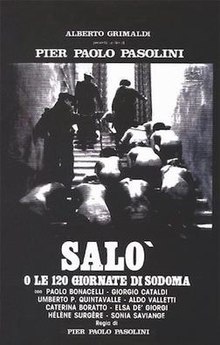 If ever there were a film whose reputation truly preceded it, that film is almost certainly Pier Paolo Pasolini’s infamous SALO, OR THE 120 DAYS OF SODOM (1975). Widely hailed as the most disgusting and/or disturbing movie of all time, it is indeed a profoundly unsettling viewing experience. It’s also a thoughtful, poetic and even beautiful piece of work, which in a strange way only intensifies the horror.
If ever there were a film whose reputation truly preceded it, that film is almost certainly Pier Paolo Pasolini’s infamous SALO, OR THE 120 DAYS OF SODOM (1975). Widely hailed as the most disgusting and/or disturbing movie of all time, it is indeed a profoundly unsettling viewing experience. It’s also a thoughtful, poetic and even beautiful piece of work, which in a strange way only intensifies the horror.
As one of the few who can lay claim to reading the Marquis de Sade’s 18th Century opus THE 120 DAYS OF SODOM cover to cover, I can attest that it’s a vile, offensive and deeply psychotic novel. It’s the story of four wealthy libertines who imprison several young people in an elegant villa and subject then to every imaginable variety of sexual torture. The novel, allegedly written on a long strip of parchment while de Sade was imprisoned in the Bastille, is essentially a catalog of perversions which by the end devolves into a dispassionate listing of atrocities.
The legendary Pier Paolo Pasolini made this film during a period of disillusionment following his bawdy “Trilogy of Life” (THE DECAMERON, THE CANTERBURY TALES and THE ARABIAN NIGHTS). SALO OR THE 120 DAYS OF SODOM (SALO O LE 120 GIORNATE DI SODOMA), adapted from Sade’s novel but relocated to Mussolini’s republic of Salo during the waning days of WWII, was Pasolini’s grimmest film by far. It was intended as a metaphor for the tyranny of consumerism, but its horrors took on a very real context when Pasolini was stabbed to death (allegedly) by a male prostitute mere weeks after editing was completed.
It seems many people have a difficult time separating the grisly facts of Pasolini’s murder from the content of SALO, which partially explains its reputation as the most extreme movie of all time. In truth, far more extreme films had already come and gone, including VIVA LA MUERTE (1971) and VASE DE NOCES (1974), but both are now largely forgotten while SALO has retained its notoriety.
In Salo, the short-lived Italian republic set up by Mussolini in 1944-45, four men are encouraged by fascist authorities to indulge their most depraved proclivities. They kidnap several young people and shut them up in a sumptuously decorated country villa, where over the next several days madness and murder become the norm.
Each day begins with a demonic woman telling the group a sexually tinged story, which stimulates the imaginations of the four overseers. Anal rape is a favored activity, which escalates to casual murder (a woman is forced to swallow nails) and a literal banquet of shit. A mock wedding is held with all-naked onlookers, and on another occasion the villa’s inhabitants are made to crawl around and act like dogs.
The final outrage is committed in the villa’s courtyard, where those who have disobeyed the “rules”–a young woman who cried about her Jewish mother getting executed, others who tried to escape, and others who exhibited tenderness (the ultimate sin)–are tortured to death. The overseers alternate between partaking in the torture and dispassionately observing the action from one of the villa’s upper rooms, while the ominous rumble of approaching fighter planes is heard.
Those looking for pornography or a gore fest (two things SALO has been falsely labeled) will be disappointed, as the film is a detached and contemplative affair with painterly wide shots and an excess of dissolves. Any sense of eroticism is obliterated by Pasolini’s staunch formalism, which emphasizes design and visual symmetry over emotion. Furthermore, the characters punctuate the naughtiness with lengthy philosophical discussions.
Yet as an evocation of ugliness and despair SALO has few equals. By all accounts Pasolini was in an extremely depressed mood when he made this film, and an all-consuming sense of hopelessness suffuses the finished product. The copious scenes of humiliation and torture are made all the more unsettling by the fact that the victims rarely ever make much of a fuss about their mistreatment, having already abandoned all hope. The film’s sole revolutionary moment, when a young man gives the communist salute before being littered with bullets, is in keeping with Pasolini’s nihilistic mood: once a committed Marxist, in this scene he grudgingly acknowledges that politics and revolution have lost any power they might once have held.
Of course SALO is most impressive from a pure filmmaking standpoint. It has a poetic sheen, with sumptuous art direction by the great Dante Ferretti, crisp cinematography by Tonino Delli Colli, and, in the final sequence, perhaps Pasolini’s most daring use of the medium. In it we see the torture in the courtyard entirely through binoculars, with only the rumbling of fighter planes (and a portion of CARMINA BURANA) as aural accompaniment. In this way we literally assume the eyesight of the torture’s overseers, which appears to have been Pasolini’s goal all along. May filmmakers have posited that the audience is complicit in the horrors they depict onscreen, but none more forcefully than Pier Paolo Pasolini in SALO OR THE 120 DAYS OF SODOM.
Vital Statistics
SALO OR THE 120 DAYS OF SODOM (SALO O LE 120 GIORNATE DI SODOMA)
Produzioni Europee Associate/United Artists
Director: Pier Paolo Pasolini
Producers: Alberto De Stefanis, Antonio Girasante, Alberto Grimaldi
Screenplay: Pier Paolo Pasolini (and Sergio Citti, Pupi Avati)
(Based on a novel by the Marquis de Sade)
Cinematography: Tonino Delli Colli
Editing: Nino Baragli, Tatiana Casini Morigi, Enzo Ocone
Cast: Paolo Bonacelli, Giorgio Cataldi, Umberto P. Quintavalle, Aldo Valletti, Catarina Boratto, Elsa De Giorgi, Helene Surgere, Sonia Saviange, Sergio Fascetti, Bruno Musso, Giuliana Melis
